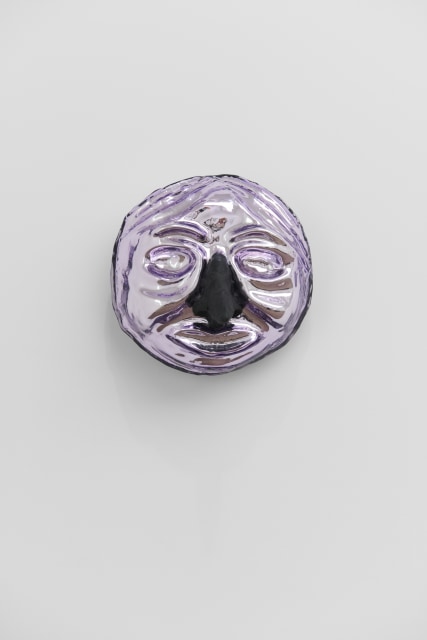Notes on the Art of Olof Marsja, in Occasion of the Opening of A Gathering of Watchers, Seers and Geists Discussing the Probability of Them Experiencing True Light.
“Matter feels, converses, suffers, desires, yearns and remembers”
Karen Barad(1)
The traces of a skeleton carved in pine wood and craftily assembled pops out of the soft and lush weavings of a reindeer pelt. The shiny fur that mixes with the opaque graininess of the wood is met at the belt with a bright orange ratchet strap, tightening the slim waist of this body and holding a few black glass flowers leaning from its side. The figure wearing these flowers is both reminiscent of a person wearing a bit of an original version of traditional Sámi clothes, a contemporary trendy one I would say, and at the same time of a ghost, a spooky presence gazing at us from high up with its glowing orange head. It is at the meeting of these opposites that the viewers meet the strength of Olof Marsja’s art, where noble materials meet their opposites, where humour meets the fright and anger of an oppressed people, the Sámis, Marsja’s ancestors, and the part of his background he has grown used to hide as children in Luleå, and that in time has become such an important part of his political views and of his art. Therein lies also the trick, or better the plot twist. It is not in the political that the Swedish artist has found the key to his art, and neither it is there that we should look for it, but the opposite. It is in the spontaneous development of his figures, the way in which he is able to translate his personal experience in these complex and fascinating creatures, and images and materials. There we should look for understanding these sculptures, these complex and simple forms that always sit at the meeting point between feelings, emotions, expressions. Their in-betweenness is a key factor in understanding what we look at when we are looking at Olof Marsja’s art, these figures that seem angry and benign, laughing at us or begging for help, looking wise or reckless. All this is filtered by Marsja’s love and incredible capacity to create images and figures which draws attention and magnetically attracts viewers towards their unexpected shapes and forms, fascinating because of their incredible tactility and the graininess coming from his craft, the way in which materials can speak, their timelessness and same time extreme connection to nowadays trends. It has recently become a funny idea of mine imagining how it would be to avoid bringing up Olof Marsja’s background to new viewers, and see how one could introduce a practice such developed, without the need of the political and intersectional crutch. The thing is that I believe it would work. These works are too rich in detail, emotion, craftsmanship to need anything further in order to stand on their own, to fascinate and leave viewers in awe, to attract and sometimes offend (a positive quality of artworks in my opinion). Funnily enough the first work that Marsja considered as mature, and to the height of his production was, literally, a crutch, carved in pine, upside down. A memory of a broken achilles tendon, of learning during a year abroad at the Helsinki Art Academy that his practice was not originating from abstract political ideas, but from the personal and the intuitive, from a drive as clear and strong as the one from which only great art can originate. Imagine only what is the delivery when onto this fertile grounds a truly felt and undoubtedly important political experience is also transferred, and politics that are personal to him, to his family, his youth. There one finds greatness in my opinion, but it is an opinion that is shared, when the same eyes looking at us in these beautiful rooms at Public Service Gallery, look from the walls and halls of more and more museums, reminding us of the power of visual art, its capacity to make us idiosyncratically discover anew the reality around us, and sometimes, even, to remind us there are stories that are worth to be told again and again to never forget them, to never have them repeat, to try and adjust the injustice that still holds its grip on more than a people around the world, like it still is for the Sámi in the north of Europe.
Mattia Lullini
(1) From Rick Dolphijn and Iris van der Tuin, New Materialism: Interviews & Cartographies (2012). Accessed digitally on May 7th, 2025 at https://quod.lib.umich.edu/o/ohp/11515701.0001.001/1:4.3/--new-materialism-interviews-cartographies?rgn=div2;view=fulltext . .


